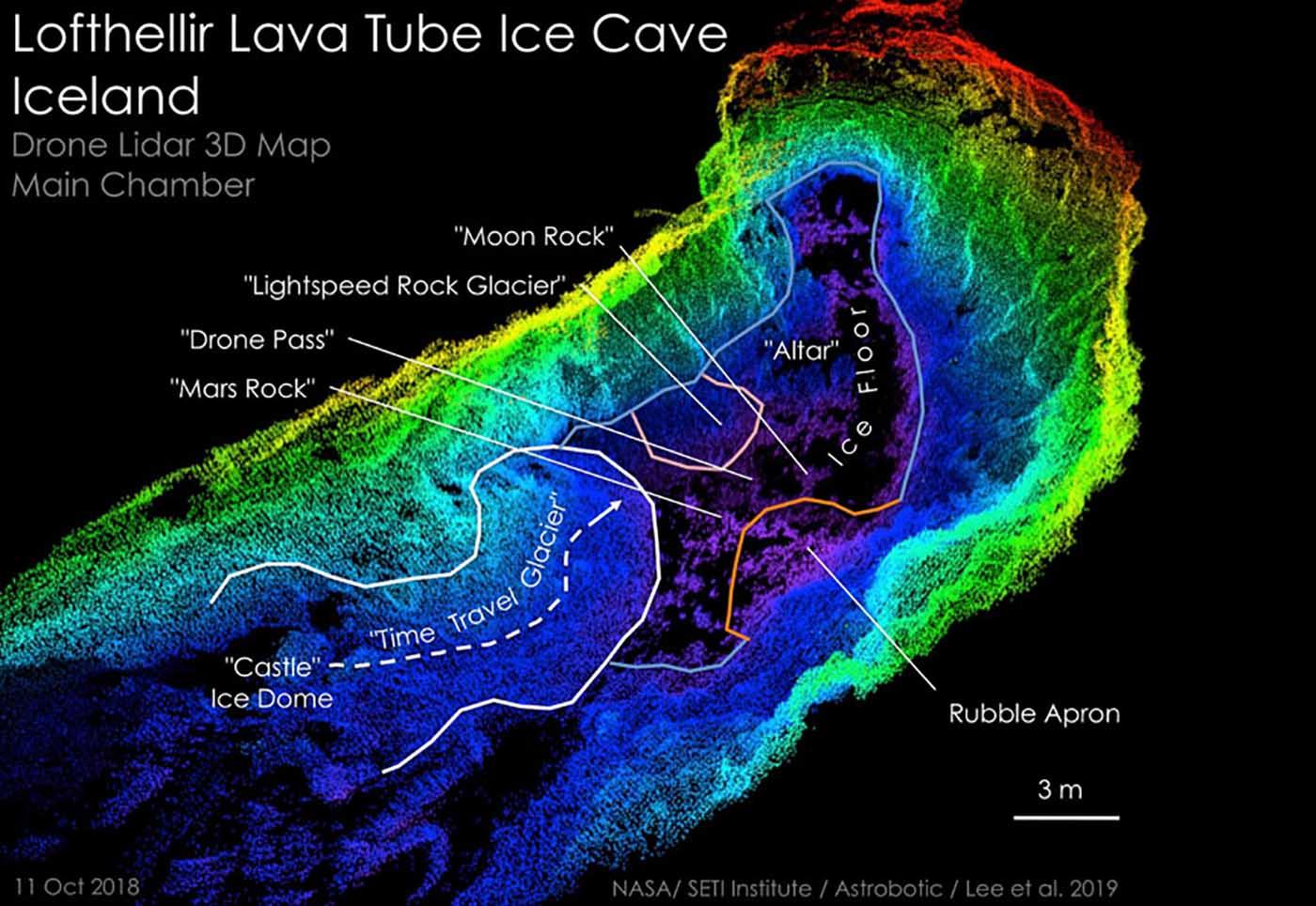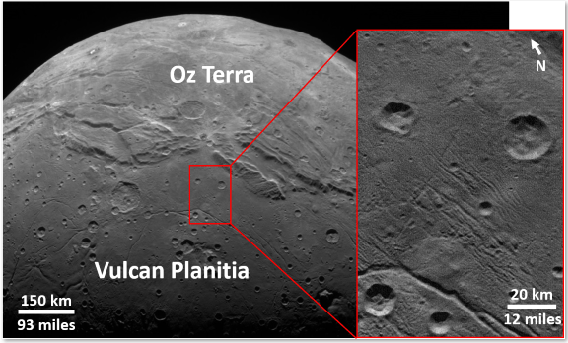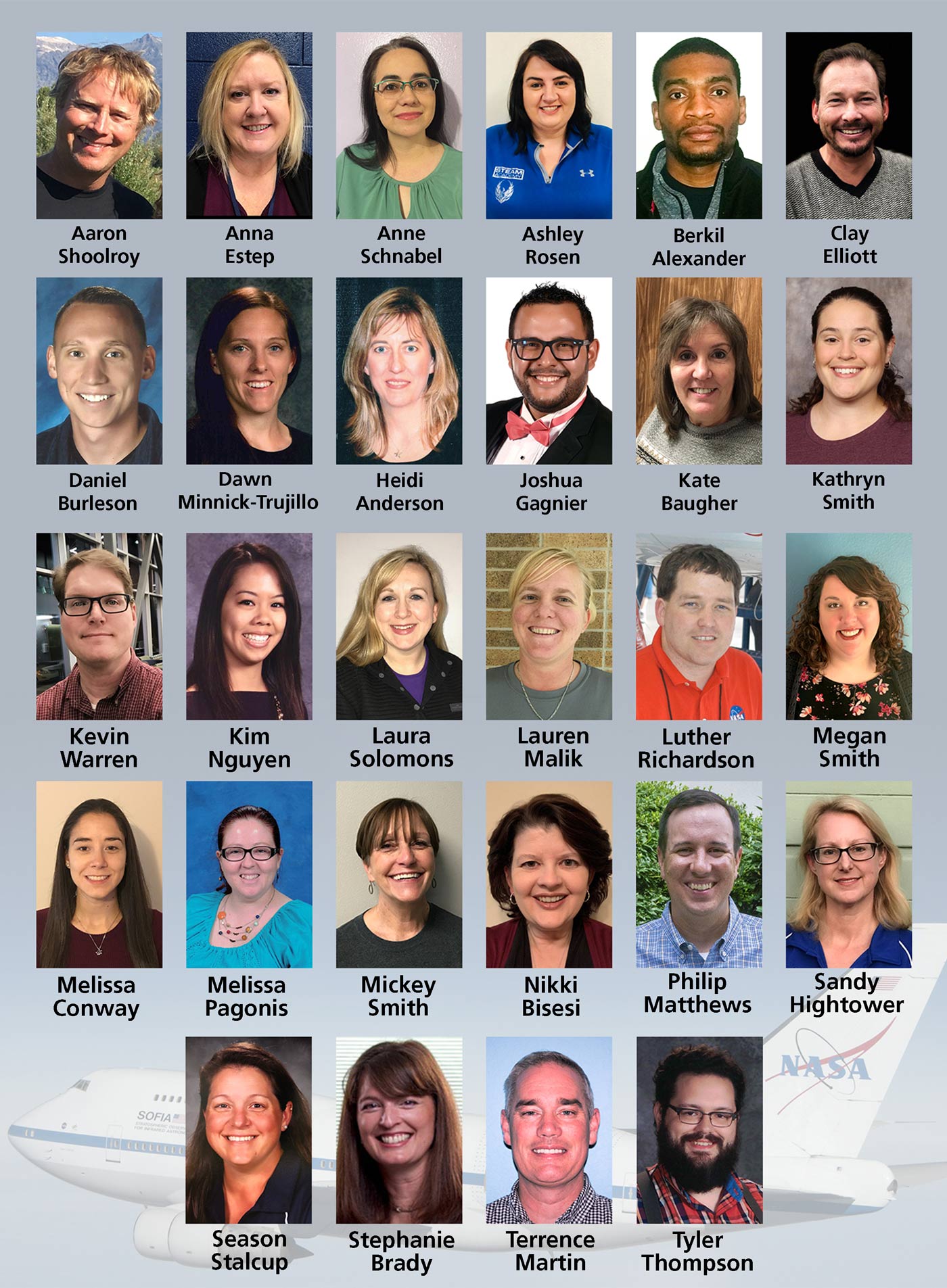
The SETI Institute announced successful 3D mapping of ice-filled lave tubes in the Myvatn region of Iceland using Astrobiotic Technology, Inc.’s LiDAR-equipped drone. Spatial Source was among those to cover the efforts of SETI Institute senior planetary scientist Pascal Lee, who led the field team:
Testing a terrestrial drone and LiDAR system at the Lofthellir ice tube cave in Iceland, SETI Institute planetary scientist Pascal Lee said that caves in the lunar or martian environments could give shelter from inhospitable conditions on the surface: radiation, wide temperature swings, and micrometeorite bombardment.
“We went to Iceland to study a lava tube with massive amounts of ice inside it to understand better both the potential hazards and opportunities presented by the many lava caves we hope to explore on the Moon and Mars,” he said.
Cave openings on the surface of both the Moon and Mars have been detected and may grant access to regions that are sheltered from the harsh temperature shifts and intense radiation – useful for explorers, and perhaps even settlers, one day. The ability to probe such tunnels with small, unmanned spacecraft that map an area in minutes, as the Astrobotic drone and LiDAR did in Iceland, would be an important step not just in space exploration, but in exploring otherwise inaccessible regions of Earth for research.
- Spatial Source: Mapping on Mars with LiDAR-equipped space drones
- MIT Technology Review: A drone map of lava tubes shows how we'll go spelunking on Mars
- International Business Times: NASA Backs Alien-Hunting Scientists Who Want To Explore Moon, Mars Caves
- New York Post: Alien-hunting scientists are developing ‘space drones’ to explore caves on Mars
- Daily Mail: 'Space drones' being used to explore lava tubes in Iceland could help NASA detect signs of life on Mars
- Drone Below: Drone Used to Map Lava Tubes in Preparation for Space Exploration
- SETI.org: Drone Maps Icy Lava Tube in Iceland in Preparation for Cave Exploration on the Moon and Mars
 22 Million Years Old Meteorite Fell in Turkish Village in 2015
22 Million Years Old Meteorite Fell in Turkish Village in 2015An international team of researchers studying meteorites that came down in Turkey in 2015 have deduced that the fragments came from a 22 million year old impact crater on the asteroid Vesta. Peter Jenniskens, senior research scientist at the SETI Institute, took part in the field study. Space Daily picked up the SETI Institute’s press release on the findings:
"We used video security camera footage in nearby cities to determine the meteor's trajectory and orbit," says Peter Jenniskens, a SETI Institute researcher at NASA Ames Research Center, who participated in the field study to investigate the meteorite's origins. "The orbit provided the first dynamical link between the normal HED meteorite clan and the inner main belt where Vesta is located."
The meteoroid was about 1 meter in size when it entered Earth's atmosphere at a speed of 17 kilometers per second from a north-western direction. It fragmented at an altitude of 27 km, based on how the meteorites were scattered near the village of Saricicek.
"With the information about how the meteoroid broke into fragments and how often HED meteorites fall to Earth, we calculated that the source crater on Vesta needed to be at least 10-km in diameter," says Jenniskens. "Most material ended up in meteoroids 0.25 to 1.25 meters in size."
Jenniskens believes these results will help with understanding the properties of other, potentially dangerous breakaways from Vesta, and may help in forming a plan of action should one be detected approaching Earth.
- Space Daily: Turkish Meteorite Traced to Impact Crater on Vesta
- Daily Sabah: Meteorites landed on village 22-million-years-old: scientists
- Wiley Online Library: The Sariçiçek howardite fall in Turkey: Source crater of HED meteorites on Vesta and impact risk of Vestoids
 New Horizons Reveals Key Details about Kuiper Belt
New Horizons Reveals Key Details about Kuiper BeltThe New Horizons spacecraft conducted a historic flyby of Pluto back in 2015, and researchers are still digging into the data collected by the intrepid probe. A study recently appeared in the journal Science which shows there were fewer craters than expected on the surface of Pluto and its satellite, Charon. Researchers from the Lunar and Planetary Institute (LPI), the Lowell Observatory, and NASA’s Ames Research Center contributed to the study, as did SETI Institute senior research scientist Ross Beyer, who works extensively on planetary surface studies.
Impact craters provide clues to the history of celestial objects, and prior to the New Horizons mission little was known about distant Pluto. Scientists were surprised to find fewer impact craters than expected on Pluto’s surface, given its nearness to the Kuiper Belt, a region of icy objects that are remnants from when the Solar System formed. The new research suggests that there are surprisingly few small Kuiper Belt objects (KBOs), and offers important insights into how the early Solar System developed.
- Universe Today: Pluto and Charon Don't Have Enough Small Craters
- Science Magazine: Impact craters on Pluto and Charon indicate a deficit of small Kuiper belt objects
- JHUAPL: New Horizons research indicates small objects are surprisingly rare in the Kuiper Belt
 EARTHLING: Connecting through Sound
EARTHLING: Connecting through SoundThe Earthling project and Felipe Pérez Santiago, of the SETI Institute’s Artist-in-Residence program, were part of a panel discussion at SxSW. Inspired by the 1977 Voyager spacecraft’s Golden Records - a golden disk containing the images, sounds, and music of Earth - Earthling carries that spirit forward into our digitally connected age and by Jill Tarter, astronomer and Chair Emeritus for SETI Research at the SETI Institute, the project aims to unite humanity through voice, sound, and global collaboration, as together we look to the stars and ask if we’re alone in the universe. Pérez Santiago described the four-phase project to Singularity Hub:
First, the team will launch a web-based platform, the EARTHLING Audio Database, to gather samples of human voices from all over the world. “Voice is the first way humans started making music,” Pérez Santiago said.
They’ll focus on sounds that convey a sense of peoples’ cultures, homelands, and ancestors. “People should contribute in a way that’s culturally representative of who they are,” Pérez Santiago said. The platform will be geo-located, showing where on the globe each sound came from.
The next phases will involve combining the sounds with the music of the Earthling Symphony, which is planned to premiere at the SETI Institute’s radio observatory in California, the Allen Telescope Array. Samples will then be available for artists to use in their own creative, collaborative compositions; an app will also be developed to allow anyone, with or without musical knowledge, to create their own works. The final phase will be sent into space, an homage an update to the Golden Record that captures the sound of humanity today.
You can learn more about Santiago and SETI AIR programs on our website, SETI.org.
- Singularity Hub: SETI Is Making a New ‘Mixtape for Aliens’, and You Can Contribute
- Earthling Project: Join the Movement
- SETI.org: SETI Artists-in-Residence Felipe Pérez Santiago to Perform at Montalvo Arts Center
- SETI.org: SETI AIR: SETI Institute’s Artists in Residence
 US Teachers Celebrate Selection for SETI Institute Airborne Astronomy Ambassador Program
US Teachers Celebrate Selection for SETI Institute Airborne Astronomy Ambassador ProgramExcitement is mounting as school districts across the United States share the announcement of twenty-eight high school science teachers selected to take part in the SETI Institute’s NASA Airborne Astronomy Ambassador Program (AAA). Selected teachers participate in a year-long professional development program and will have the opportunity to fly aboard SOFIA, a highly modified Boeing 747SP airliner equipped to study celestial objects at infrared wavelengths, and participate in infrared astronomy. The program includes in-person and web-based training, and a curriculum module that helps teachers bring their real-world STEM immersion experience into the classroom.
Educators participating in the 2019 AAA program were selected from districts in California, Nevada, Georgia, South Carolina, Kentucky, Texas, and Oklahoma.
- News 4: Two WCSD Teachers Chosen to Become Nasa Airborne Astronomy Ambassadors
- KOLO 8: Two WCSD teachers selected for NASA program
- KyForward: Two Fayette County teachers among 28 selected as 2019 NASA Airborne Astronomy Ambassadors
- Las Vegas Review-Journal: Las Vegas Academy teacher will get training at NASA facility
- Washoe County School District: Two WCSD Teachers Chosen to Become Nasa Airborne Astronomy Ambassadors
- SETI.org: High School Science Teachers Named Airborne Astronomy Ambassadors – Will Fly on NASA’s SOFIA Aircraft
 Space Exploration, Life Detection, and Keeping an “Experimental Mindset”
Space Exploration, Life Detection, and Keeping an “Experimental Mindset”A recent piece in Korn Ferry Institute’s Briefings Magazine looked at space travel and the importance of having ‘an experimental mindset’. Keeping an open mind is especially important when considering the possibility of finding life on other worlds. SETI Institute President and CEO Bill Diamond would seem to share the sentiment, especially regarding seemingly inhospitable worlds like Mars. Diamond noted that life has been found in surprising places on Earth, and what that might mean for Mars exploration:
“Extensive research of so-called ‘extremophiles,’ or living organisms thriving in extreme environments, has had profound implications for our understanding of life in the universe,” says Bill Diamond, President and CEO of the SETI Institute in California, whose mission is to look for life beyond Earth. “We see biology in environments we previously thought were impossible for supporting life. These findings raise the probability of finding evidence of life that once was, or perhaps still is, on Mars—most likely at the microbial level.”
Advances in exoplanet detection – work that scientists with the SETI Institute are heavily involved in – strengthens the case that life in the universe may prove to be abundant:
The SETI Institute manages the data pipeline and wrote the software algorithms for the Kepler Space Telescope, to detect planets orbiting other stars. “Life appears to be very robust,” adds Diamond, a physicist who spent his career in applied technologies. “Add the fact that habitable Earth-like planets are everywhere, and the probability that we are alone in this universe is essentially zero.”
- Korn Ferry Institute: Lessons from the Cosmos
 Friedemann Freund on the Origin of Life
Friedemann Freund on the Origin of LifeIn an article for Open Access Government, SETI Institute senior research scientist Friedemann Freund discusses possible ways chemical compounds necessary for life could have arisen. Some scientists suspect that these compounds developed in an unknown process in space and then fell to Earth in meteorites. Freund posits a different idea - that “the reactive gases dissolved in the magmas in the depth of Earth – water, carbon monoxide and dioxide, even nitrogen and sulphur – would become incorporated into every mineral grain that crystallizes out of terrestrial magmas”, and then interact and bond while cooling, creating the organic molecules necessary for life and “releasing them as they weathered at the Earth’s surface”.
- You can read more about Dr. Freund’s work on our website, SETI.org.
- Open Access Government: A new turn in the search for the origin of life
- Open Access Government: Earth science: The Search for the Origin of Life
- SETI.org: Scientist Interview - Friedemann Freund - The Future of Forecasting Earthquakes
 Stellar Motion as Space Travel May Answer Fermi’s Paradox
Stellar Motion as Space Travel May Answer Fermi’s ParadoxWhere is everybody? That’s the question physicist Enrico Fermi posed in his famous paradox, which examines the contradiction between the likelihood that intelligent extraterrestrial beings exist, and the lack of evidence of the same. A classic argument that attempts to explain the Fermi paradox posits that the vast distances between stars would prohibit any intelligent civilization from spreading much farther than their own system, because it would simply take too long to develop and pursue interstellar travel. A new paper under review by the Astrophysical Journal counters this argument: aliens could take advantage of the movement of stars to spread more quickly across the galaxy. Just as Earth travels around the Sun, the Sun travels through the Milky Way – this stellar motion might allow the spread of life to occur faster than previously considered. Natural variations in this movement would mean that only some galaxies would be fully settled, while some – perhaps ours – more sparsely. While this explanation might allow for both abundant life in the universe and our cosmic loneliness, senior astronomer Seth Shostak offered his own thoughts on the paradox to Quanta Magazine:
Seth Shostak, an astronomer at the SETI Institute who has studied the Fermi paradox for decades, thinks it is likely to be explained by something more complex than distance and time — like perception.
Maybe we are not alone and have not been. “The click beetles in my backyard don’t notice that they’re surrounded by intelligent beings — namely my neighbors and me,” Shostak said, “but we’re here, nonetheless.”
- Quanta Magazine: Galaxy Simulations Offer a New Solution to the Fermi Paradox
- The Atlantic: Moving Stars Might Speed the Spread of Alien Life
- Digital Trends: Is the truth out there? New paper proposes solution to the Fermi paradox
- The Daily Galaxy: “Unvisited for Millions of Years” –New Spacefaring Solution to the Fermi Paradox
- SETI.org: Could We Be Alone in the Cosmos?
- SETI.org: Fermi Paradox
In last week’s episode, a look at the sometimes-contentious relationship between science, political engagement, and activism, in an encore of Skeptic Check: Political Scientist. On our previous week’s episode, the BiPiSci team follows a world-renowned physicist’s journey to understand the nature of the universe in an encore of Hawkingravity.
Last time on Facebook Live, a conversation with SETI Institute CEO Bill Diamond talks with SETI Institute’s Peter Jenniskens about the link between meteorites found in Turkey and the asteroid Vesta. Videos of all past Facebook Live events can be found on our Facebook page: https://www.facebook.com/SETIInstitute/
- The Future of Women in STEM: March 27, 2019, Oakland, CA The SETI Institute’s Margaret Race will be one of the featured panelists
- Women in STEM: March 28, 2019, Lafayette, CA Margaret Race will be one of the featured speakers
- Osher Lifelong Learning Institute, Astrobiology: April 1-29, Santa Clara, CA Instructors will include SETI Institute scientists Margaret, Race, Michael Busch, and Rosalba Bonaccorsi; former Director of Education at the SETI Institute, Edna DeVore, will also be teaching a segment
- Department of Earth and Planetary Sciences, University of Tennessee: April 4, 2019, Knoxville, TN Senior Research Scientist Janice Bishop will be the featured speaker
- Stockton Astronomical Society: April 11, 2019 Stockton City, CA SETI Institute scientist Meng Jin will give a presentation
- Puerto de Ideas VI Festival de Ciencia: April 12-14, 2019, Antofagasta, Chile Nathalie Cabrol, Director of the Carl Sagan Center at the SETI Institute will be a featured speaker





